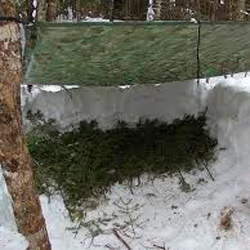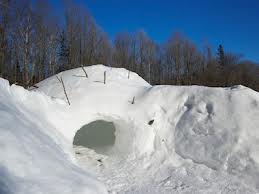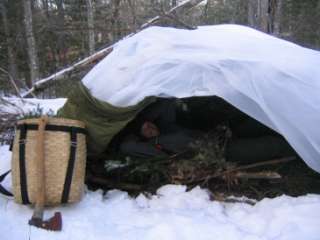Winter Survival Shelter: Snow Shelter, Bush Shelter, and Urban Survival Shelters
If caught outside in the winter, a winter survival shelter is necessary for the survival of you and your family, as severe cold winter conditions can lead to hypothermia and ultimately death. Your location, its topographical features and the amount of time you have to plan will dictate the type of shelter you can build.
An important safety precaution is whatever shelter you build, be sure to consider proper ventiliation, as asphyxiation is a danger when trying to keep the cold out or heating with fuels that compete for the oxygen in your shelter.
The very basic bug out bag for building a winter survival shelter is:
- Ground cloth or tarp
- Cutting tool, preferably a large knife
- Small sleeping bag
- Fire-making device
- Some type of shovel, especially if you will be dealing with snow
Snow Shelters
If you are in a region of significant snow accumulations, you can build a snow shelter. Igloos can be made from blocks of snow and are a long term but still a temporary shelter. With a large knife and snow shovel, you build an igloo by:
- Cutting dry hard packed snow in blocks about three feet long, eight inches deep and 15 inches high.
- Placing the blocks in a circle, stacking them, leaning them inward building a type of dome.
- Digging a hole to gain entrance into the structure.
- Creating air holes for ventilation.
For an igloo, you need a lot of hard packed snow, which usually is not found outside of the arctic, but you can buy snow molds from Outdoorpros or Amazon. The molds make snow blocks smaller than the ones you cut from the snow so it takes longer to construct your shelter. You simply pack the snow into the mold to form the snow blocks you need for your igloo.
Other options for a winter survival shelter include building a large mound of snow six to eight feet tall, then tunneling out an entrance and living space or making a snow cave from a large snowdrift. A quinzee is a large snow cave with a raised shelf for resting and sleeping near the ceiling and a cold air pit on the floor. This allows cold air to settle and when you are on the shelf, you take advantage of the heat rising from your body
Another option for a snow winter survival shelter is a snow trench, where you dig into the snow to make the trench. You cover the top with branches and/or a tarp for a roof. You should not lie in the snow but use pine boughs, brush or a tarp to insulate your body against the cold of the snow.
Unless your snow shelter is very large, you should build your fire in a separate outside space. Having a fire inside the shelter, you have the risk of asphyxiation and destructive melting of your snow shelter, leaving you wet and susceptible to hypothermia.
Brush Shelters
Using a tree trunk, already bowed branches or a fallen tree can ease the work needed to build the brush shelter, but you will still need:
- Framing - Using bendable saplings for a frame can create a dome like structure. You can use tree limbs to frame a teepee type of structure or even a hut.
- Walls - To insulate against wind and cold, you can use branches and brush to build walls. If possible, you can use the vegetation to camouflage your winter survival shelter so it blends into the surroundings.
- Using pine boughs with the needles pointed to the ground will cause the rain or melting snow to flow off the shelter rather than into the shelter.
With great care, you can build a small warming fire pit in the entrance of the shelter or outside of your shelter. Since brush is highly flammable, you need to use extreme caution.
Caves
Caves offer a ready-made shelter but you should be sure no large, meat eating and/or territorial animals have already made it their home. You check that the rock is stable and not likely to crumble in large chunks, that it is a dry cave and that you have enough room and ventilation for a fire.
Urban Winter Survival Shelter
The city setting provides a broad opportunity for survival shelters. You can use Styrofoam, cardboard boxes and even furniture to insulate from the winter cold. It is important to provide adequate ventilation and to build the shelter so it does not draw unwanted attention.
If your home is usable, cutting, taping and insulating cardboard to make a sleeping container will help you retain or regain body heat. Do not use camping stoves or heaters until you have made sure you have plenty of ventilation for a source of fresh air to prevent carbon monoxide poisoning.
A winter survival shelter needs to keep you and your family warm as it protects you from the elements. As with all preparation for catastrophic events, you should practice your skills by building the shelters before the day when your survival depends on it.
Return from Winter Survival Shelter to Survival Retreat








New! Comments
Have your say about what you just read! Leave me a comment in the box below.